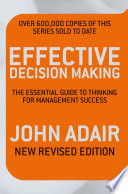

Effective decision-making begins with a thorough understanding of the decision-making processes. The book emphasizes that decisions are not made in a vacuum; they are influenced by various factors including cognitive biases, social influences, and emotional states. The author outlines different decision-making models, such as rational decision-making, bounded rationality, and intuitive approaches. By recognizing the strengths and weaknesses of each model, readers can tailor their approach to different situations, ensuring that they make more informed and balanced decisions. The importance of gathering relevant information and assessing the context in which a decision is made is also highlighted, enabling individuals to navigate complex scenarios effectively.
Continue readingIn the age of information, the book underscores the critical role of data and analytics in decision-making. Effective decision-makers leverage quantitative data to support their choices, moving beyond intuition alone. The author discusses various analytical tools and techniques, such as SWOT analysis, cost-benefit analysis, and predictive modeling, which can help in evaluating options and forecasting outcomes. By integrating data into the decision-making process, individuals can minimize uncertainty and make choices that are not only rational but also backed by empirical evidence. The emphasis on data-driven decision-making is particularly relevant for leaders and managers who must navigate complex business environments.
Continue readingCognitive biases can significantly hinder effective decision-making. The book identifies common biases such as confirmation bias, anchoring, and overconfidence, which can distort judgment and lead to poor outcomes. The author provides strategies for recognizing and mitigating these biases, such as seeking diverse perspectives, questioning assumptions, and employing structured decision-making frameworks. By fostering awareness of cognitive biases, individuals can enhance their critical thinking skills and make more objective decisions. This section is particularly valuable for professionals who must make high-stakes decisions where the cost of errors can be substantial.
Continue readingEffective decision-making often requires collaboration and input from multiple stakeholders. The book discusses the benefits of collective decision-making, including the pooling of diverse knowledge and perspectives, which can lead to more innovative solutions. The author outlines techniques for fostering collaboration, such as brainstorming sessions, consensus-building exercises, and the establishment of clear communication channels. By promoting a collaborative culture, organizations can enhance their decision-making processes and ensure that all voices are heard. This idea is crucial for leaders who aim to create inclusive environments that value teamwork and collective intelligence.
Continue readingThe book stresses the importance of evaluating the outcomes of decisions and learning from both successes and failures. The author advocates for a systematic approach to post-decision analysis, where individuals reflect on the decision-making process, the information used, and the results achieved. This reflective practice not only aids in personal growth but also contributes to organizational learning. By documenting lessons learned, teams can refine their decision-making frameworks and improve future outcomes. This concept is vital for continuous improvement and is particularly relevant in fast-paced industries where agility and adaptability are key.
Continue readingEmotional intelligence (EI) plays a significant role in effective decision-making. The book highlights how self-awareness, empathy, and emotional regulation can influence choices and interactions with others. The author provides insights into how individuals can cultivate their emotional intelligence to enhance their decision-making capabilities. By understanding their emotional triggers and the emotions of others, decision-makers can navigate interpersonal dynamics more effectively and foster a supportive environment for collaborative choices. This idea is essential for leaders who must balance rational analysis with the emotional aspects of decision-making.
Continue readingIn an ever-evolving world, the ability to adapt to change and uncertainty is paramount for effective decision-making. The book discusses strategies for embracing flexibility and resilience in the face of shifting circumstances. The author emphasizes the importance of scenario planning, risk assessment, and contingency strategies to prepare for potential challenges. By fostering a mindset that is open to change, individuals can make more agile decisions that allow for course corrections as needed. This adaptability is particularly crucial for entrepreneurs and leaders who operate in dynamic markets where rapid shifts can occur.
Continue reading